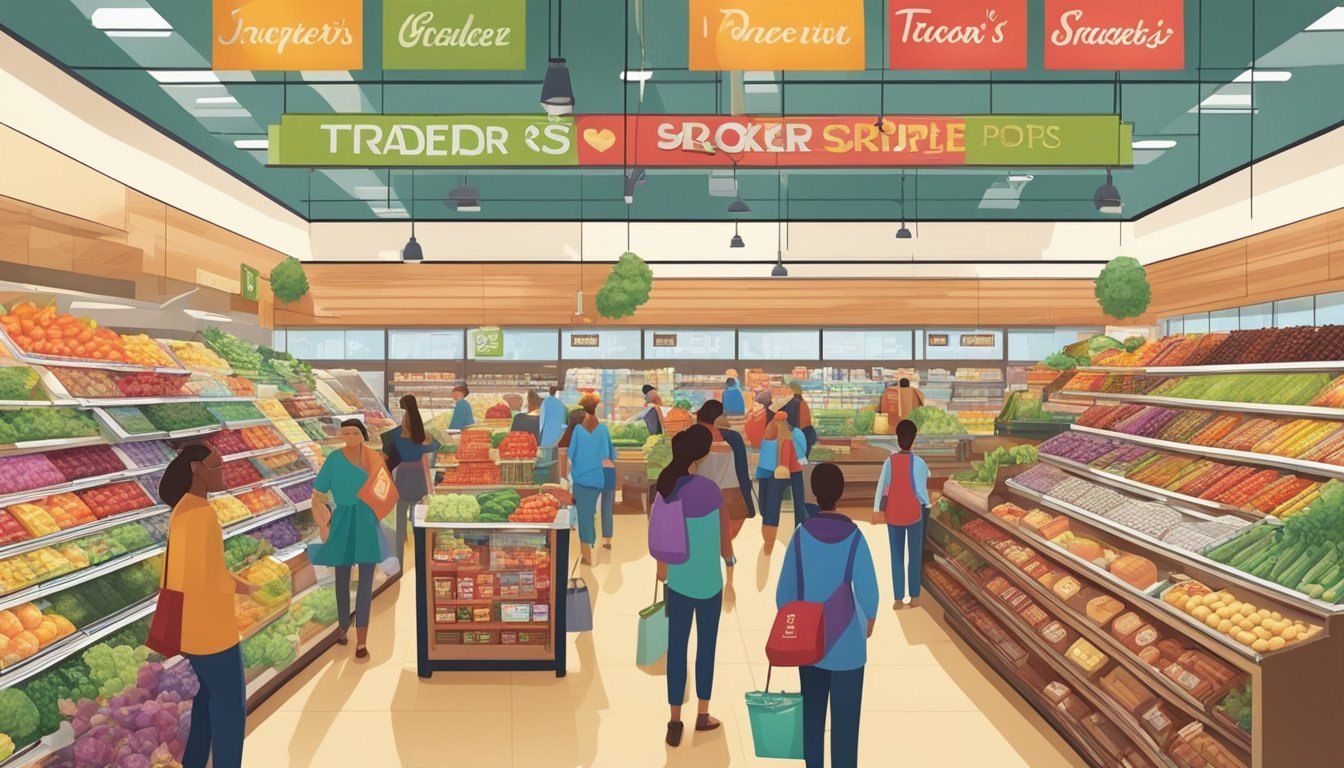Trader Joe's vs ShopRite
Comparing Quality, Prices, and Selection
Part of Our Grocery Store Guide with Details on Trader Joe's and ShopRite
Shopping for groceries can be a very personal experience, as each consumer seeks a combination of value, quality, and convenience that fits their lifestyle and budget. Trader Joe's and ShopRite are two grocery store chains that have garnered attention in this regard. Trader Joe's, known for its eclectic selection of private-label products, has built a loyal following with its competitive pricing and unique offerings, including a variety of affordable fancy cheeses, wines, dips, and more. ShopRite, on the other hand, is perceived as a more traditional supermarket, offering a wider variety of national brands alongside its own store brand.
When comparing the two, consumers often look at pricing as a major deciding factor. Research suggests that Trader Joe's prices are, on average, lower than those found at ShopRite. This is particularly noticeable in the produce section, where Trader Joe's pricing is approximately 5% lower. With grocery store choices influencing both household budgets and meal quality, the decision between these two stores often comes down to individual preferences and priorities, such as the importance of organic options, the convenience of store locations, and the variety of inventory that aligns with dietary needs and culinary habits.
Moreover, beyond sheer pricing, the shopping experience itself may sway consumers one way or the other. Trader Joe's smaller, more curated stores with a frequently rotating selection contrast with ShopRite's expansive aisles and comprehensive offerings. Each store's business model caters to different shopper tendencies, whether they are looking for a quick and adventurous shopping experience or a one-stop-shop for all household needs. As such, determining which grocery store is "better" isn't a one-size-fits-all answer but rather a reflection of the match between a store's attributes and the shopper's personal criteria for value, quality, and experience.
Company Profiles and Histories
Trader Joe's began as a small chain of convenience stores called Pronto Markets in 1958. The founder, Joe Coulombe, rebranded the stores in 1967 to the now-familiar Trader Joe’s and introduced the unique nautical theme still in place today. Employees are referred to as "crew members," locations as "stores on the high seas," and the store's atmosphere includes a bell that is rung to signal various activities, emulating the communication style of a ship.
The stores are known for their distinctive marketing approach, which focuses on value products, predominantly under the Trader Joe's brand name. The selection is carefully curated to offer a mix of everyday staples, gourmet items, and exotic offerings from around the world. Trader Joe's is acclaimed for its selection of organic produce and for operating in a business model that emphasizes high-quality products at affordable prices.
ShopRite operates under a cooperative network of supermarkets primarily in the northeastern United States. While ShopRite's history is not as marked by a singular theme as Trader Joe's, the brand has its own unique identity. The cooperative is made up of a consortium of individual owners who operate ShopRite stores. It started in 1946 when a sales representative from Del Monte Foods noted that independent grocers could benefit from banding together for buying power, equivalent to grocery chains.
ShopRite takes pride in offering a full-service experience which includes custom meat cuts provided by in-store butchers and an extensive selection of meat products. ShopRite stores also typically offer a range of grocery items that cater to the needs of the communities they serve, leveraging the power of group purchasing to keep prices competitive while providing a broad product selection.
Store Brand and Product Selection
When comparing Trader Joe's and ShopRite, one must consider store brand offerings, product selection, including name-brand products, and the availability of exclusive and diverse high-quality items.
Private Label Products
Trader Joe's excels in its private label products, which account for a significant portion of its inventory. The brand is known for offering a competitively priced range, including organic and gluten-free options. The Trader Joe's brand products typically offer a mix of traditional grocery items and eclectic food choices, appealing to a variety of taste preferences.
Name-Brand Products
ShopRite, on the other hand, stocks a wide array of name-brand products alongside its store brand, SE Grocers. This ensures that customers have access to well-known brands that they trust, in addition to more budget-friendly store brand options. Their name-brand selection extends across all departments, from dairy to the frozen section.
Exclusive Items
Trader Joe's boasts a selection of exclusive items that can't be found at other grocery stores. These include specialty cheeses, unique wine selections, and various international food items. ShopRite's selection includes seasonal and regional exclusives which appeal to local preferences.
Product Variety and Quality
Both stores provide a broad diversity in their product lines. Trader Joe's is commended for its high-quality produce, organic offerings, and healthy options. ShopRite has a robust produce section including both conventional and organic produce, a full bakery, and a comprehensive meat and dairy selection. Each store ensures that a range of gluten-free and veggie sticks are available, catering to health-conscious shoppers. The quality of products offered at both stores receives consistently positive feedback from consumers.
Consumer Shopping Experience
This section examines the shopping experience at Trader Joe's and ShopRite, focusing on store design, customer service, and checkout efficiency.
Store Design and Atmosphere
Trader Joe's is renowned for its unique store design that often features a nautical theme with wooden crates and hand-written signage creating a laid-back, friendly shopping atmosphere. ShopRite stores often have a more traditional supermarket layout, emphasizing straightforward navigation and organization. Customers may feel that Trader Joe's offers a more personable experience, while ShopRite provides familiarity and practicality.
Customer Service
Customer service at Trader Joe's is generally very well-received, with employees known for being cheerful and helpful. They are often easily identifiable in Hawaiian shirts, contributing to the store's approachable image. ShopRite also takes service seriously, ensuring that staff is available to assist customers; however, they may not have the same distinct presence as Trader Joe's staff.
Checkout Efficiency
When it comes to checkout efficiency, both Trader Joe's and ShopRite have implemented systems to keep wait times to a minimum. Trader Joe's smaller store size can sometimes lead to quicker checkouts, as there are fewer aisles to navigate. ShopRite, however, with its larger stores and higher volume of traffic, employs multiple checkout options, including self-service kiosks, to maintain efficiency.
Pricing Comparison
In evaluating Trader Joe's and ShopRite, cost effectiveness and specific benchmark items are critical factors for consumers watching their budgets while seeking high-quality groceries.
Overall Cost Effectiveness
Trader Joe's has demonstrated a competitive edge in overall pricing strategies. For produce, one of the key savings categories, Trader Joe's reportedly offers prices approximately 24% lower than its competitors. Even when compared at the item level, Trader Joe's consistently maintains an advantage in offering cost savings to consumers. With the absence of supplier fees and an emphasis on private label products, Trader Joe's can curate a selection that balances both price and quality.
Benchmark Items
A more granular look at essential grocery items underscores the pricing difference between Trader Joe's and ShopRite.
Produce: Trader Joe’s produce prices are about 5% lower than ShopRite.
Meat: Comparing meat prices, Trader Joe’s offers about 6% lower pricing than its competitor.
For budget-conscious shoppers, these savings can be significant over time. While Trader Joe's may not have the extensive selection of some larger stores like Costco or Walmart, its emphasis on affordability without sacrificing quality is apparent. ShopRite similarly offers competitive pricing and often runs sales that can provide short-term savings, but Trader Joe’s consistent everyday low prices define its market position.
When considering overall cost effectiveness, it’s noteworthy that Trader Joe’s also competes well against other grocery chains such as Aldi and Whole Foods, often providing consumers with a middle ground of affordability paired with quality selections.
Convenience Factors
When assessing the convenience factors of ShopRite and Trader Joe's, customers consider the accessibility of store locations and the ease of online shopping and delivery options. These factors significantly influence consumer choices within the grocery market.
Store Locations
Trader Joe's operates in numerous states, but they have fewer locations than some competitors, focusing on select urban and suburban areas. ShopRite has a stronger presence in the Northeastern United States, with multiple stores in each state, making it more accessible to a larger number of customers seeking physical store visits.
Online Shopping and Delivery Options
ShopRite offers an online shopping experience with delivery options, catering to the increasing demand for convenience. Customers can shop through the website or the ShopRite app. Delivery services may include an annual fee for some membership programs or a fee per delivery, varying by location.
Delivery Service: Provided by ShopRite and third-party vendors
Membership: Optional membership for benefits
Trader Joe's does not offer an in-house online shopping or delivery service. However, customers can use third-party delivery services, where available, to purchase Trader Joe's items. These services often partner with Amazon Prime and other delivery ecosystems, sometimes involving additional costs or delivery fees.
Delivery by Third-Party: Amazon Prime and other similar services
Annual Fee/Delivery Fee: Varies depending on the third-party service used
Sustainability and Community Impact
Trader Joe's and ShopRite have recognized the increasing consumer demand for sustainability and have implemented various eco-friendly initiatives to reduce their environmental impact while also engaging with local communities to foster positive relationships and support.
Eco-Friendly Initiatives
Trader Joe's commitment to sustainability is evident in its adoption of several eco-friendly policies. This includes minimizing plastic packaging by overhauling its packaging practices to reduce plastic usage. They aim to make all packaging renewable, recyclable, or biodegradable. In line with these efforts, Trader Joe's has made strides in reducing plastic bag use and offering more sustainable options.
ShopRite also participates in eco-friendly efforts. Focused on reducing the environmental footprint, ShopRite incorporates energy-efficient technologies in their stores and works on reducing waste. For instance, ShopRite has been incorporating more recyclable materials and has placed a considerable emphasis on offering products that come with less packaging.
Local Community Engagement
Both Trader Joe's and ShopRite engage with the communities they serve, albeit in different ways. Trader Joe's operates on a local neighborhood scale, often tailoring stores to fit local needs and preferences. Their social impact extends to charity donations, where unsold but still viable products are donated to local food banks.
ShopRite, on the other hand, has a strong presence in the communities it serves. They host various events and programs to benefit local causes and work closely with community leaders to address the needs of residents. They also place a strong emphasis on employing workers from within the community, thus contributing to the local economy.
Customer Loyalty and Brand Trust
Trader Joe's and ShopRite are recognized for cultivating customer loyalty and securing brand trust, which are critical for success in the competitive grocery industry.
Return Policies
Trader Joe's is known for its generous return policy, extending confidence to its customers in product satisfaction. They allow returns without a receipt and often without the need to bring back the item in question. This policy undoubtedly contributes to a high level of customer trust and leads to greater loyalty.
In contrast, ShopRite also offers a return policy that values customer satisfaction, though they typically require a receipt for returns. Their policy is designed to ensure customers feel comfortable with their purchases.
Customer Satisfaction
Trader Joe's has garnered a significant trust share, especially noted for its exclusive private label products that undergo rigorous product development before reaching the shelves. This ensures customers consistently enjoy high-quality and unique offerings, fostering a trusting relationship between the brand and its patrons.
ShopRite, on the other hand, focuses on providing a wide range of brand options, meeting the needs of a diverse customer base and maintaining satisfaction through variety. Their stores often feature various customer services and community programs, reinforcing a positive and loyal customer base.
Both stores prioritize cleanliness, ease of finding items, and a friendly cashier experience, all of which play essential roles in building brand trust and encouraging repeated patronage. Free samples, when offered, are a form of service joy that enhances shopping experience and can boost customer loyalty.
Wrapping Up: The Verdict
When it comes to choosing between Trader Joe's and ShopRite, consumers have distinct options to consider in the supermarket landscape. Trader Joe's often boasts a diverse array of private label offerings that cater to those seeking gourmet items at reasonable prices. Additionally, their pricing strategy eliminates supplier fees, allowing for cost savings on products ranging from specialty cheeses to wines.
ShopRite, meanwhile, serves a broader market with a more conventional range of national and store brands. They provide robust weekly specials and savings through their Price Plus Club membership, appealing to customers who capitalize on sales and discounts.
In a head-to-head comparison on price, Trader Joe’s has demonstrated a competitive edge, particularly in produce and essential grocery items. For example, they offer approximately 5% lower prices on produce compared to ShopRite, which can be a deciding factor for budget-conscious shoppers.
One aspect that divides the two is shopping experience. Trader Joe's stores are typically smaller with a curated selection, which might appeal to those in search of a quick shopping trip. ShopRite’s larger size and wide product range may attract customers looking for variety and one-stop shopping.
With these considerations, it is evident that both Trader Joe's and ShopRite excel in different areas. The verdict hinges on consumer priorities, whether it's price, product selection, or shopping experience. Customers seeking cost-effective gourmet options may favor Trader Joe's, while those valuing a vast array and frequent sales might lean towards ShopRite. Each supermarket has carved out its niche, ensuring they remain strong competitors in the grocery store market.
Appendix
This section provides supplementary material to enhance the reader's understanding of the comparative analysis presented in the main article. It includes sources for further reading, details on research methodology, and a curated list of references.
Additional Resources
For readers who desire a broader context or deeper insight into grocery shopping trends, the following resources may be beneficial:
"The Economics of Grocery Stores" by Michael R. Baye
"Consumer Behavior: Building Marketing Strategy" by Del I. Hawkins et al.
Methodology
The methodology for the comparative analysis involves:
Price Comparison: A selection of commonly purchased items were compared between Trader Joe's and ShopRite.
Shopping Experience Assessment: Criteria such as store layout, customer service, and product availability were evaluated.
References
The following references support the content and findings within the main article:
"ShopRite vs. Trader Joe's - Which Is Better?" - The Grocery Store Guy
"Ways Trader Joe's Is Better Than Other Grocery Chains" - Real Simple
"I Compared the Cost of 48 Items at Trader Joe's and a Typical Grocery Store" - Date of Publication: Aug. 7, 2023
Reddit Thread: "Northeast people: ShopRite vs Trader Joe's?" - r/Frugal
"Supermarket Comparison: Where to Go Grocery Shopping on a Budget"








